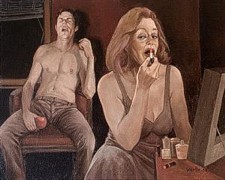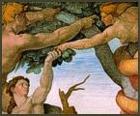“Like Eating God”
Posted by Eric (April 4, 2006 at 3:54 pm)
 Twice this past weekend I caught the end of a segment on the public radio program This American Life which was apparently some kind of retelling of the story of Adam and Eve and the Garden of Eden. I happened to tune in right at “the Fall”—an appropriate moment here in the thick of Great Lent.
Twice this past weekend I caught the end of a segment on the public radio program This American Life which was apparently some kind of retelling of the story of Adam and Eve and the Garden of Eden. I happened to tune in right at “the Fall”—an appropriate moment here in the thick of Great Lent.
The piece, what I heard of it, sounded irreverent, even somewhat mocking, but it was interesting nonetheless, especially lines like this one, where Adam is reminiscing about the Garden long after the banishment:
“When you ate the fruit in Eden, it was like eating God,†he would say, “and God was delicious. When you wanted him, you just grabbed him.†Now when he ate fruit, he could only taste what was not there.
“Like eating God.” That line reminded me of Schmemann, somehow, and I wanted to hear the whole segment; I was disappointed to tune into the same show on another station, at just about the same point. Today I tracked down the RealAudio file of the show, themed “Starting from Scratch” which originally aired in 2003. The segment I heard is by Jonathan Goldstein and starts at about 42:30.
There’s plenty to object to in Goldstein’s retelling. Adam is a “lummox,” the “village idiot” and the wise, cynical Eve finds him tiresome. The snake is likewise dismissive of Adam, using him to get to Eve, by whom he is intrigued. I’m not sure what Goldstein is really getting at in this piece—I’m not sure even Goldstein is; the point, like so much on these eclectic public radio programs, might just be cleverness itself.
But along the way Goldstein offers some fascinating little insights. Here’s another one, from the first half of the story, when the snake meets Adam for the first time:
“I’ve seen you around with another one like you,†[the snake] said to Adam, “but instead of the dead, legless snake between the legs, she has chaos there.â€
The woman has “chaos” between her legs. How do you even begin to unpack that? On one level, he’s got it completely wrong; what’s between Eve’s legs isn’t chaos but nothing less than the very princple of order in the created world: motherhood. But this is the snake—the serpent, the deceiver, Satan—and what he sees there is chaos—the potential of the woman’s body for bearing not life but chaos, disorder, disintegration, death.
Here’s another fascinating line, one of Eve’s first impressions upon eating of the fruit of the Tree of the Knowledge of Good and Evil:
She felt a thousand little feet kicking at her uterus.
There it is: the Fall of Man, where not only Adam and Eve fall, but, in them, the whole human race. Amazing what potential for insight there is in this story, even in an irrevent retelling by an aparantly areligious author.
Pictures of Adam and Eve
About the image above: I saw this painting in a window of a gallery on Harrison Street in the “art district” of Oak Park, IL. I used to live in that neighborhood. I took a photo of the painting, which I assumed was some kind of weird rendition of the Garden of Eden. There was no title on it, I don’t see how it could be anything else.
To continue this theme of modern “retellings” of the story of Adam and Eve, I offer this painting by Marvin Werlin, which I found online quite by accident:
 Fascinating. There’s Adam, apple in hand, only inches away from a rather phallic fold in his trousers; after the Fall, he has become self-aborbed, his face twisted as if in sexual climax; he’s lost interest in Eve. Eve, however, is looking sidelong at Adam, applying makeup to her face as if in the vain hope of attracting him once again (“your desire will be for your husband”). The consequences of the Fall. Orignal sin.
Fascinating. There’s Adam, apple in hand, only inches away from a rather phallic fold in his trousers; after the Fall, he has become self-aborbed, his face twisted as if in sexual climax; he’s lost interest in Eve. Eve, however, is looking sidelong at Adam, applying makeup to her face as if in the vain hope of attracting him once again (“your desire will be for your husband”). The consequences of the Fall. Orignal sin.
G.K. Chesterton called the doctrine of original sin “the only part of Christian theology which can really be proved” (Orthodoxy). Perhaps that is why the story of Adam and Eve continues to so fascinate artists and writers today, just as it has done through the centures.



